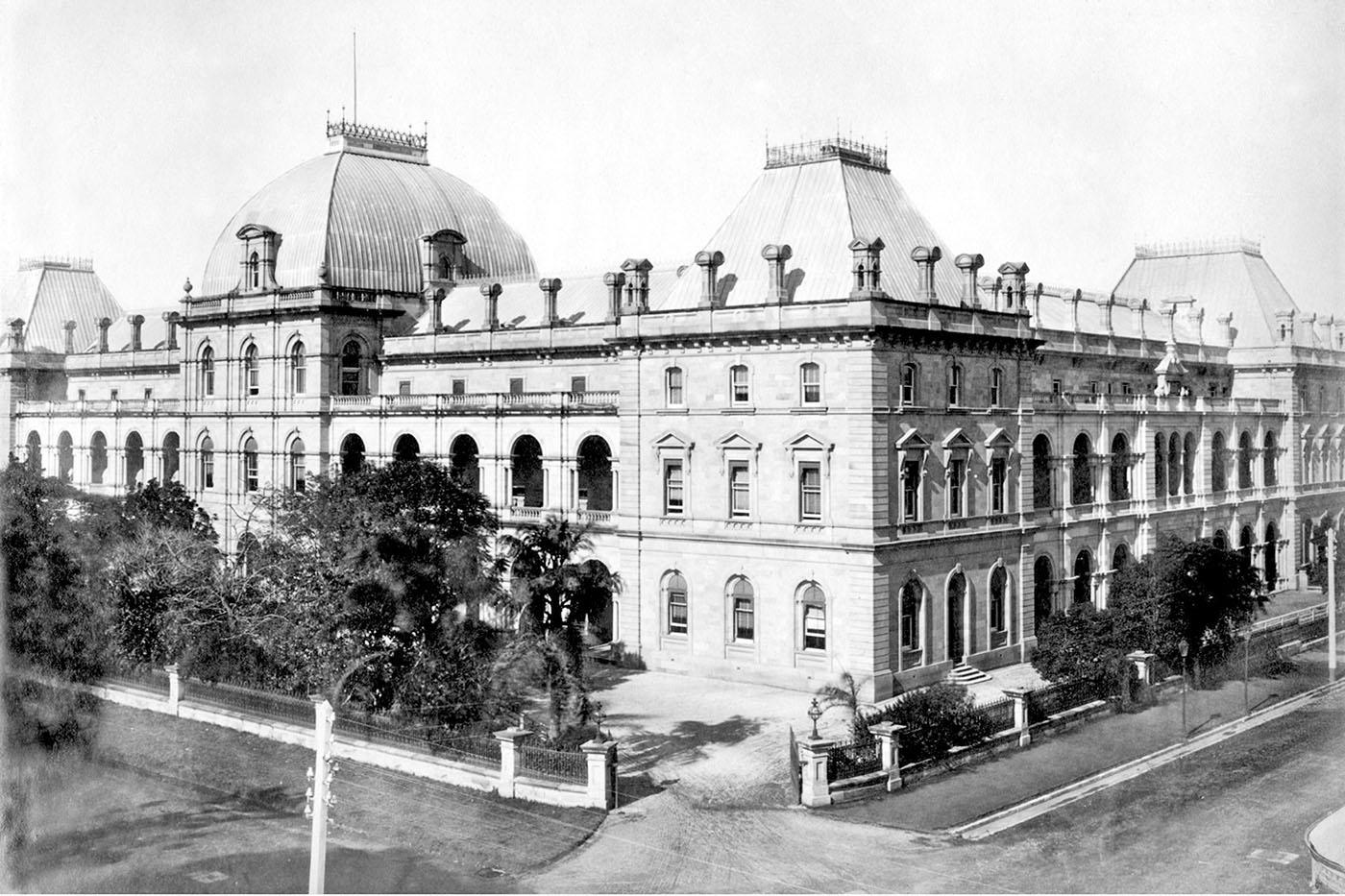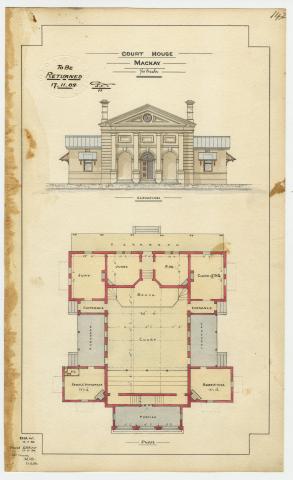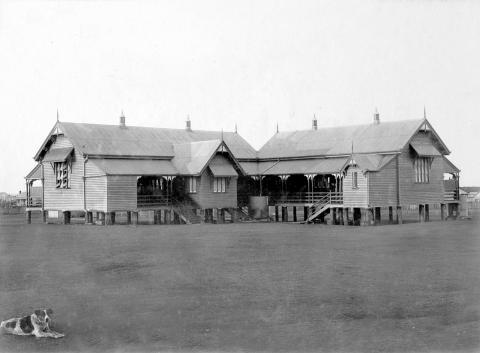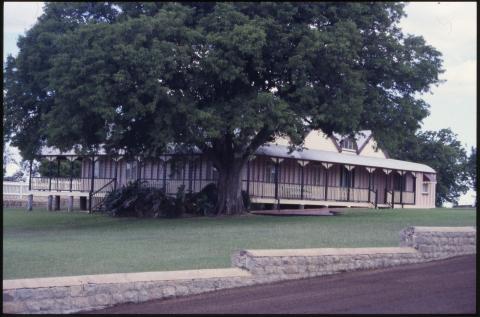
- News of the day
-
Brisbane Courier, Tuesday 24 June 1890, page 4
TUESDAY, JUNE 24, 1890.
The third session of the tenth Parliament of Queensland will be opened at noon to-day by his Excellency the Governor in person. Members of both Houses will assemble in their respective Chambers shortly before that hour, and ladies and gentlemen who hold cards of entree will be admitted to the Legislative Council Chamber at half-past 11 o'clock. Sir Henry Norman will leave Government House a few minutes before 12 o'clock and drive to Parliament House, where he will be received by a guard of honour formed of members of A Battery, Permanent Force. His Excellency will be conducted to the Council Chamber, and having taken his seat on the dais will request the attendance of members of the Legislative Assembly, who, headed by the Speaker, will present themselves at the bar of the House. Having requested them to be seated, the Governor will read the customary Speech from the throne, after which he will return to Government House with his suite. The Headquarters Band will be in attendance within the precincts of Parliament House; and a salute of seventeen guns will be fired by the Brisbane Garrison Battery from the saluting battery, Queen's Park, at a few minutes before noon and on the departure of his Excellency from Parliament House. In the afternoon both Houses will meet at the usual hour, when, after the transaction of any formal business, the discussion of the Address in reply will be entered upon. In the Council the proceedings at this stage are usually very brief; but in the Assembly advantage is always taken of the opportunity for airing any grievances which may have arisen during the recess. It is understood that in the Speech will be enumerated the following measures, which, amongst others, it is intended to deal with this session :- A Factories and Workshops Bill, a bill for the protection of young girls, a Harbours Trust Bill, a bill enforcing the registration of bills-of-sale, a District Courts Bill, a Married Woman's Property Bill, and a Lien Bill. Included in the matters to be brought forward soon after the opening of Parliament will be the federation proposals, the appointment of delegates to the Federal Convention, and measures to give effect to the postal proposals dealt with at the recent conference. It is believed that reference will be made in the Speech to the intention of the Government to introduce a measure with the view of making the Upper House an elective body, and it is understood that the Government propose to continue the double endowment to local bodies for a further period. The Address in reply is to be moved in the Assembly by Mr. Callan, member for the Fitzroy, and seconded by Mr. Lissner, member for the Kennedy. A caucus meeting of the members of the Ministry and their supporters was held in the Executive Council Chamber, Treasury Buildings, yesterday forenoon. All the Ministers were present, and a large number of their party; and telegrams were read from several other members intimating their inability to be in town by today, but stating that they would be in attendance at the House within the next few days. We understand that the principal business was the discussion of arrangements in connection with the opening of Parliament. Members of both political parties have been arriving in town during the past week, and it is anticipated that by the end of this week there will be but few absentees.
- Background
-
The main wing of Parliament House (facing George Street) was erected between 1865 and 1867 as the seat of Queensland government after separation in 1859. It was designed by Colonial Architect Charles Tiffin and is the most substantial building erected in this period. The wing facing Alice Street was constructed between 1887 and 1889, supervised by Colonial Architect, G Connolly.
Prior to separation, Moreton Bay was included in an electoral division which encompassed all areas north of Port Macquarie. By 1851 Moreton Bay had elected a Member to the Legislative Council of New South Wales, and when separation occurred the region was represented by nine Members.
In 1859, the colony of Queensland was granted separation from New South Wales and a constitution was established, based on the English Westminster system. This provided the need for a legislature in two chambers, and conversion of the previous prison barracks in Queen Street was undertaken to fulfil this.
This proved unsatisfactory and in 1864, a Commission was established to host a competition for a new House of Parliament. The committee members decided upon 20 000 as the amount which competitors should endeavour to make the basis of the probable cost. Entries were received and the design of Benjamin Backhouse was considered to be most suitable. However it proved to be too costly and the design of Colonial Architect Charles Tiffin was selected instead. This decision caused much controversy and the Commission was eventually forced to alter the previous plans and call for a new design. In December 1864 the Queensland Daily Guardian reported that the whole of the designs are to be rejected and an entirely new and original design has been adopted. The new building design is more imposing, more appropriate and will afford more accommodation.
Tiffin's new design comprised four ranges around a central court, with the Legislative chambers in the George Street range and government offices in the remaining ranges. The arrangement of space, both of the building as a whole and within the individual chambers is indicative of the way in which Parliamentary proceedings were, and still are, conducted
The building was to be erected on what was then part of Queens Park, adjacent to the Government Domain and the Botanic Gardens. The foundation stone was laid on July 14 1865 by Governor Bowen and work commenced on the George Street range.
In 1865 the Brisbane Courier described the George Street range as being 304 feet long by 86 feet deep at the centre......by 103 feet in height to the top of a curved mansard roof over the libraries and the grand staircase.
Now described as Classical Revival in style, it was then described as renaissance as adopted in the Louvre and Tulleries, but of a less ornate character and more in keeping with the position of the colony. The external walls are constructed of freestone from Mr Jeays quarry at Woogaroo and the roof was originally of English slates..... the ridges and mansards terminated with iron cresting.
Internally, the Courier described the building as plain and substantial, however finishes included large stained glass windows by Messrs Chance of Birmingham featuring portraits of the Queen, the Prince and the Princess of Wales, large and ornate sunlights, also imported from England, cedar doors with panels of open bronze work, and ornate plasterwork.
By 1867, the work was complete, although due to financial constraints, only the George Street range had been constructed.
Tiffin retired from the position of Colonial Architect in 1869 and was succeeded by F D G Stanley. The building remained as constructed until 1878 when additions were made including the construction of archways and colonnades to the George Street facade and erection of the stone and iron palisade fence to the George and Alice Street frontages.
In 1887 it was again decided to make additions to the House and the Alice Street range was constructed, completed in 1889. The Colonial Architect at this time was George St Paul Connolly, who supervised the work. Although the extension conforms to Tiffin's original design principals, it shows slight variations in the form of relief stonework panels comprising staghorns, eucalyptus leaves, gum nuts and convolvulus. The designer of these is thought to have been Thomas Pye, chief draftsman of the Department of Public Works at the time. The sculptor is unidentified, having been employed by the contractor Daniel MacDonald.
The abolition of the Legislative Council in 1922 rendered the Council Chamber obsolete. Although rarely used, the space remains intact.
The multi-storey parliamentary annexe at the rear of the original building was erected in 1979, followed by the addition of the porte cochere to the George Street range in 1981. The new porte cochere was based on Tiffin's original design, although it was increased in size to allow for the passage of cars.
In 1982, the building was renovated at a cost of thirteen million dollars. This included extensive refurbishment of all areas, including the addition of air conditioning in all rooms, the installation of security and fire protection services and externally, the replacement of finishes such as the tessellated tiles to the ground floor arcades and the original copper sheeting to the roof with a new material.
Courtesy of Queensland Heritage Register
/153.027419,-27.4748593,7/450x450@2x.png?access_token=pk.eyJ1IjoicXNhLWRpc2NvLXFsZCIsImEiOiJjamJmdTgyZXEyeWNjMnlxZm8xcmtieHgxIn0.lmT9J5tTPKGuuccQgCVSAg)



